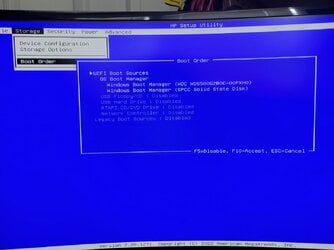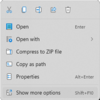- Local time
- 3:26 AM
- Posts
- 119
- OS
- Windows 11
Please read this post completely before answering. I'm running Windows 11. It is an HP Gaming desktop with a 460 GB NVM2 drive. It also has a 1TB Sata SDD that is a clone of the first that I can also boot from. The PC has an Intel I7 CPU. I pose this issue to you folks that have an intimate knowledge of the UEFI boot process. I'll try to set this up with as much information as possible. Also understand I have been working to fins a solution to this question for three years. I have read and tried untold different things to resolve the issue.
I purchase this PC new. It came with a regular 1TB HDD sata drive. When new, from the moment the power button was pressed, the PC was booted and Windows was completely running in less than 35 seconds. I later upgraded to the NVM2 drive. I used a third party app to move the information form the original drive to the NVM2. It has been so long now, I don't remember which app I used.
As well, it has been so long now. I don't remember if this issue was immediate to installing the new drive, but I think I remember the PC booting into windows in 25 seconds or less. Soon after I noticed it seemed like the PC was taking an in inordinate amount of time to boot. So, I decided to watch. This is what I have seen from that time.
I have the bios set up so I can see the Post screen. In the bios I have the Post screen delay set to none. From the moment I press the power button and I see the power light there is about 40 seconds pass before the Post screen show up on the monitor. The post screen shows for three seconds and from that point Windows is loaded in about 20 seconds. My question is WHY is there such a long pause or delay from the moment the power is applied until the post screen shows? Since the 80's I've owned or operated hundreds of PC's and this is a first for me. I have also searched an read many web sites for possible answers. I have talked with techs and engineers at HP. That was a useless exercise in futility. The HP help site and forum is full of people that cannot read. GRIN I really am open to any and all suggestions because I'm not sure I can remember or relate all the things I have tried which include:
1. updated all device drivers (many times)
2. updated the bios. (many times)
3. verified in SYSINFO that UEFI bios is enabled.
4. Changed , checked and tried a score of settings in the very limited bios screens afforded by HP. Believe me, I have tried them all.
5. Reseated and/or cleaned the contacts on all memory.
6. Reseated and/or cleaned the contacts on the NVM2 drive.
7 Reseated and/or cleaned contacts on the CPU
8.Checked all voltages from the power supply
9. Selected and deselected fast startup in Windows power settings (made no difference wither way)
10. Disconnected all devices connected to any USB port ( I really thought this was the answer. It wasn't)
11. Disconnected one of the two monitors. The PC has a GSI 1050ti video card that came in it originally.
12. Removed or uninstalled many apps.
13. Spoke with the people that I thought developed the bios (since their name was on it) they said they have nothing to do with that.
I felt a breeze.
I have not tried removing the network or video card. The PC takes the exact same amount of time to boot from the cloned secondary drive as it does from the main drive. I have not tried booting with one or the other of the drives removed. I have not tried a new motherboard. HP offered to change it out if I would box and sent the entire PC in and wait months to get it back. It's not that much of an inconvenience.
I do run Windows 11 updating almost on a weekly basis in through the Windoze insiders Dev channel. This issue started before I started this and while I was still running Win 10.
I know almost nothing about what process the PC goes through in botting from UEFI. The PC runs normally once it is booted. It is very fast. I'm sure there may be suggestions of things I have tried already. That is fine. I can't remember everything I have tried.
On every other PC I have or have every operated, once the power button is pressed and power light is on there is a second or two. Then a signal to the monitor is noticed and the post screen appears. Then, the Windows start screen appears and boots into the OS. Average time, 35 to 50 seconds.
Moment by moment description of the issue
The power button is pressed and I see the power light . There is about 45 seconds and then see the monitor get a signal, Two seconds later the post screen appears. From this point, the OS boots normally. Total of about a minute and 15 seconds.
I don't mean to sound redundant. If you can think of anything here I have not described, please let me know. I waiting on that one suggestion where I can have that "Well ugh...duh" moment. Thanks for your time.
I purchase this PC new. It came with a regular 1TB HDD sata drive. When new, from the moment the power button was pressed, the PC was booted and Windows was completely running in less than 35 seconds. I later upgraded to the NVM2 drive. I used a third party app to move the information form the original drive to the NVM2. It has been so long now, I don't remember which app I used.
As well, it has been so long now. I don't remember if this issue was immediate to installing the new drive, but I think I remember the PC booting into windows in 25 seconds or less. Soon after I noticed it seemed like the PC was taking an in inordinate amount of time to boot. So, I decided to watch. This is what I have seen from that time.
I have the bios set up so I can see the Post screen. In the bios I have the Post screen delay set to none. From the moment I press the power button and I see the power light there is about 40 seconds pass before the Post screen show up on the monitor. The post screen shows for three seconds and from that point Windows is loaded in about 20 seconds. My question is WHY is there such a long pause or delay from the moment the power is applied until the post screen shows? Since the 80's I've owned or operated hundreds of PC's and this is a first for me. I have also searched an read many web sites for possible answers. I have talked with techs and engineers at HP. That was a useless exercise in futility. The HP help site and forum is full of people that cannot read. GRIN I really am open to any and all suggestions because I'm not sure I can remember or relate all the things I have tried which include:
1. updated all device drivers (many times)
2. updated the bios. (many times)
3. verified in SYSINFO that UEFI bios is enabled.
4. Changed , checked and tried a score of settings in the very limited bios screens afforded by HP. Believe me, I have tried them all.
5. Reseated and/or cleaned the contacts on all memory.
6. Reseated and/or cleaned the contacts on the NVM2 drive.
7 Reseated and/or cleaned contacts on the CPU
8.Checked all voltages from the power supply
9. Selected and deselected fast startup in Windows power settings (made no difference wither way)
10. Disconnected all devices connected to any USB port ( I really thought this was the answer. It wasn't)
11. Disconnected one of the two monitors. The PC has a GSI 1050ti video card that came in it originally.
12. Removed or uninstalled many apps.
13. Spoke with the people that I thought developed the bios (since their name was on it) they said they have nothing to do with that.
I felt a breeze.
I have not tried removing the network or video card. The PC takes the exact same amount of time to boot from the cloned secondary drive as it does from the main drive. I have not tried booting with one or the other of the drives removed. I have not tried a new motherboard. HP offered to change it out if I would box and sent the entire PC in and wait months to get it back. It's not that much of an inconvenience.
I do run Windows 11 updating almost on a weekly basis in through the Windoze insiders Dev channel. This issue started before I started this and while I was still running Win 10.
I know almost nothing about what process the PC goes through in botting from UEFI. The PC runs normally once it is booted. It is very fast. I'm sure there may be suggestions of things I have tried already. That is fine. I can't remember everything I have tried.
On every other PC I have or have every operated, once the power button is pressed and power light is on there is a second or two. Then a signal to the monitor is noticed and the post screen appears. Then, the Windows start screen appears and boots into the OS. Average time, 35 to 50 seconds.
Moment by moment description of the issue
The power button is pressed and I see the power light . There is about 45 seconds and then see the monitor get a signal, Two seconds later the post screen appears. From this point, the OS boots normally. Total of about a minute and 15 seconds.
I don't mean to sound redundant. If you can think of anything here I have not described, please let me know. I waiting on that one suggestion where I can have that "Well ugh...duh" moment. Thanks for your time.
My Computer
System One
-
- OS
- Windows 11
- Computer type
- PC/Desktop
- Manufacturer/Model
- HP Pavilion Gaming 790-0077c
- CPU
- I7 8700
- Motherboard
- Berks Form factor: ATX, 36.45 x 24.88 cm (15.35 x 9.79 in)
- Memory
- 16gb
- Graphics Card(s)
- MSI 1050t
- Sound Card
- Creative SoundBlaster AE-9
- Monitor(s) Displays
- Twin Samsung 27" curved
- Screen Resolution
- 1920 x 1080
- Hard Drives
- 512Gb and 1Tb




























